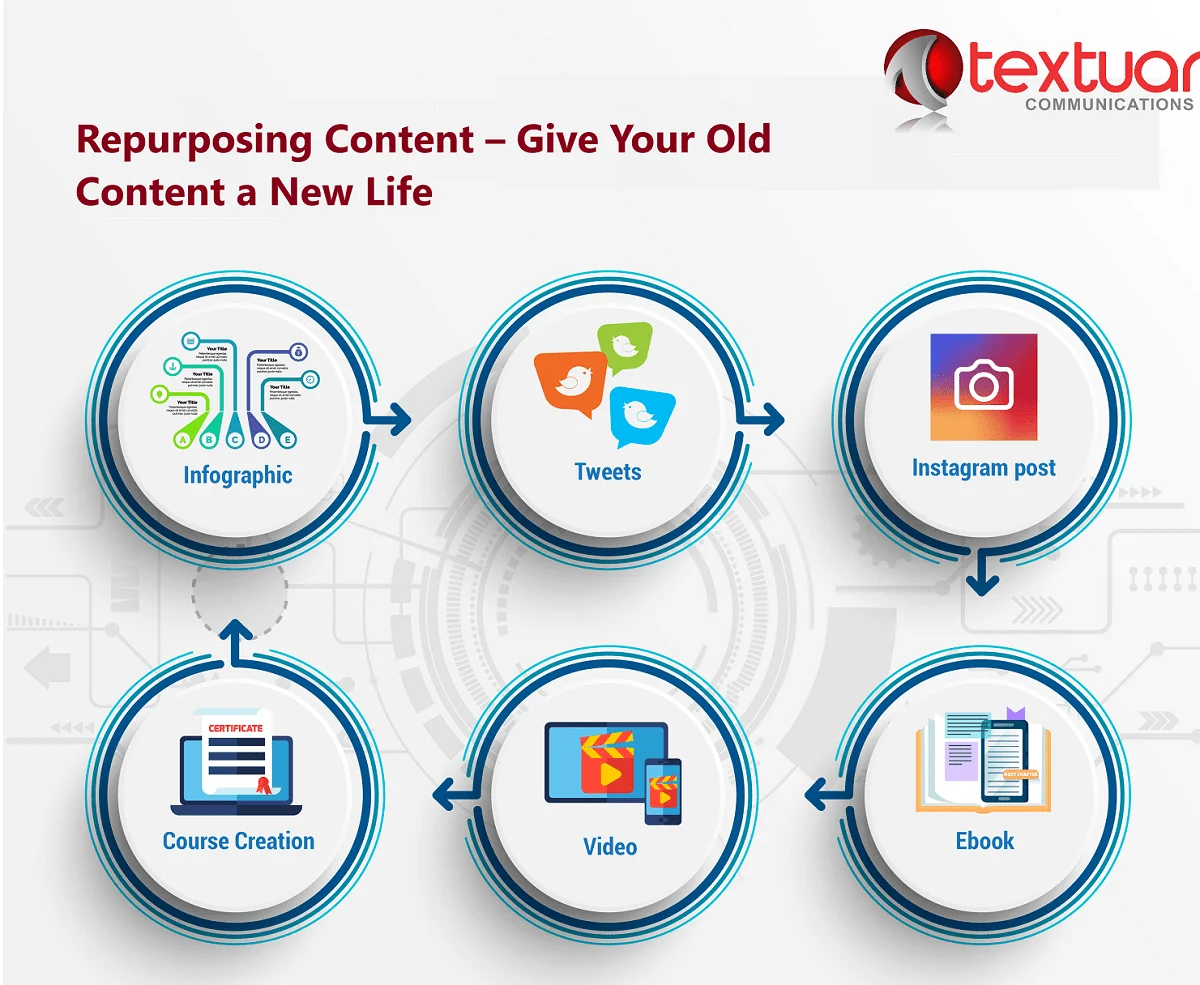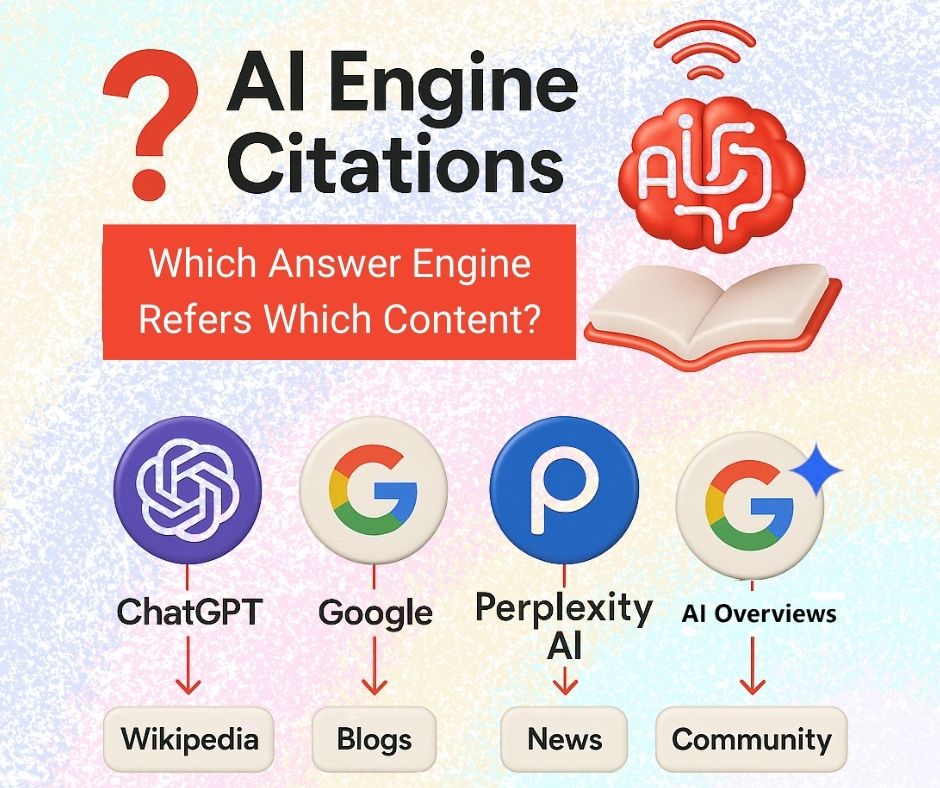Every month, marketers spend time with a good content writing company to create content that is useful as well as to stay in sync with the current timeline. Over the years, you might have built a very good content repository on your blog section this way. But after a few months of its publishing, the content usually dies a slow death.
It is here that repurposing existing content drives phenomenal value.
You can polish the old content and add new nuggets of info. This helps in garnering a fresh set of eyeballs. Doing so makes your past blogs look appealing and relevant to current times.
What is repurposing of content?
When you want to extract more SEO value from your existing content, then it is termed as content repurposing. You can reuse the content from one platform and re-build it for another platform.
The process involves taking an existing piece of content like an old blog. You can then transform it to infographics, social media posts and videos. If you observe closely, the core message remains the same. But you alter it a bit to make it suitable for more diverse audience preferences and specific platform needs.
With content repurposing you can leverage your best performing content assets. Using this, you can reinforce the key marketing messages across multiple channels. It is a cost-effective way for marketers to keep up with the new content production demands while reaching a broader audience.
Why should you go for repurposing of content?
Expand Readership & Audience
Users on different platforms also have a tendency to embrace content that is more relevant to them. Let’s take a classic example of LinkedIn. The users on LinkedIn will accept data related to career productivity, business opportunities, and work-related stuff (nothing about personal or casual themes). So if you have a B2B blog on your website, why not refurbish it on LinkedIn? You can also convert the data on the B2B blog to a Pinterest image.
2. Keeping it fresh via repurposing content
Content, after a few months, starts moving out of sight as it gets replaced by newer content. No matter if they had been chartbusters in their good ol’ days. Now you have a way to extract more juice from such blogs. All you need to do is repurpose content in below ways-
- A marketing presentation or help guide for the client, also find its way on sites like Slideshare
- The link to the presentation can be embedded on the site, and the links could be shared on social media
- The same links can be posted as part of the periodic newsletters you send out to your clients.
- A good blog and its vital statistics can be a good source for an infographic or a podcast.
- Important data from the blog can be used as a tweet or a social media post.
- How about turning your old PowerPoint decks into a Blog post?
- How about re-writing an old press release as a case study?
Think about it! The options are almost endless for repurposing content.
3. SEO optimization
When you create multiple pieces from a single blog, you can bolster your SEO efforts as well. This way, you can increase the number of indexed webpages. With repurposed content, you can also propel your chances of adding more internal links. This will improve your site structure and experience. When you transform content into discrete formats, you present it on various platforms. This improves visibility and drives organic site traffic as well.
How to decide which content needs to be repurposed?
Freshness Quotient of the content
Not all the posts are evergreen. For example, writing about the SEO guide applied in 2010 is not worth in 2016. Identifying the relevant content is necessary. Some content might have a good life. For example, consider a webinar that was taken a year back to give a brief introduction about the use of your services. It can always find its place in the newsletter and the site.
If there are help blogs written on any topic. They can always find its place via sites like Yahoo answers, Quora and more. The users can redirect to your site for a detailed description. It also makes you a community leader in terms of stating the knowledge base and the creditability of the company to solve problems.
2. Popularity and Use
You can do a deep, thorough analysis of the content through analytic software. It is better to understand the behavior of the users on specific posts and the hits they have received over a period of time. Using them will definitely impress the new customers and prospects that have walked in after publishing the repurposed post.
Do not forget the main criteria about the usefulness of the post before reformatting it or publishing it on other portals.
Quick ways to repurpose the content
- Create social media posts out of the content.
- Use Case Studies to create blog posts content or whitepapers
- Power Point Presentations can be made into new blog posts or case studies
- Interviews – Use as advice decks
- Text content can be transformed into Visual Content
- Statistics from blogs can be added to social media
Check Performance Metrics to Know Sources for Repurposing Content
You need to dive deep into your analytics and know which are the top-performing content pieces. You can evaluate metrics like –
- page views,
- time on page,
- social shares,
- backlinks, and
- conversion rates.
If you spot content that excels in these areas, it shows a clear sign that it has resonated with your audience. Consider a blog post with high engagement and many backlinks. This is a prime candidate for repurposing into an infographic or video series.
Also, if the content has performed well for longer duration, they are termed as ‘compounding posts.’ Since they have showcased lasting relevance, they are ideal for repurposing.
What are the Benefits of Repurposing content?
We all have heard the old adage- Content is king. But it can be quite exhausting to produce new content every other day. This is where repurposing of content helps. The key advantage is that it can help your message to stick with your audience. It allows you to get a broader audience too.
Let us take a look at its various perks-
[1] You connect and reach more people
This is one of the main benefits. Repurposing can help you reach those people that you could not tap into the first time. This might include those who skipped your content by chance or choice.
For example, a person who does not watch Instagram video content may skip your video when it appears in his feed. However, a quote card from the same clip would reach them immediately through stories. It may even result in a like.
On the other hand, if you recycle content, it will frustrate people who choose to skip it. This can potentially lead them to unfollow your page. In some ways, repurposing content into multiple formats gives people more reasons to follow you.
[2] You will not be limited by your audience’s attention span
In today’s time podcasts have the best audience when we talk about attention span. But even the biggest podcaster, like Joe Roegan, has an official channel where he posts small clips. And you should do this too!
Content repurposing can help create bite sized pieces which can be consumed across various media. It does not go one way though. You can even make long-form content using small clips of your old videos.
Content repurposing deals with three things-
-Change of size
-Change of medium
-Change of platform
[3] You become omnipresent by repurposing content
Gone are the days when follower count was the sole measure of social media success. In the post-influencer era, the outlook has shifted toward content quality. People are no longer impressed by large followings. They seek valuable and professional content from brands and experts.
If people follow you and vibe with your message they will engage with your brand on every platform. The more they engage with your content, the more it will appear in their feed.
Repurposing your content can help you build a following of super fans. The more people see you, the more they will relate to and trust you. It goes without saying that this is extremely useful for content marketers.
[4] Easily share your content
Tech platforms are constantly adapting. Netflix has added a clip-format tab. Also, Twitter has introduced social audio. Even if you are not planning to cross-post, repurposing your content for different formats within your chosen platform can be beneficial.
Here are a few ideas you can explore-
– You can take a screenshot of your Instagram DM and make a post out of it.
– You can caption a portion of your feed video audio with a B-roll or stock and turn it into an Instagram story.
So why is it important to have your content ready to jump on a new product within a social media platform? Because of reach. Every platform will give a high amount of exposure to a particular product it is promoting.
New products offer a unique advantage for early adopters, and each platform has its own strengths for sharing specific types of content. Repurposing your content for these platforms can significantly boost its reach.
[5] Your content can go viral
Repurposing helps your content get more engagement and reach. But aside from this, it also can make it viral. Well, it does not guarantee that every piece of content will rock online. But it does help in maximizing the volume.
Viral hits are mostly happy accidents. This is why you should not solely focus on it. Virality for creators of content are a volume driven accident. Almost every YouTuber might say they did not expect that video to go viral.
We think that if you focus on creating more content, then you might hit the jackpot. You may end up creating something that is unique and valuable. Repurposing allows you to maximize the volume of your content. You do not know which image, video, audio or GIF will go viral on which platform.
Instead of a one-hit-wonder approach, give your content multiple opportunities for virality.
[6] You spend less time creating content
Let us take the viral theory further. Suppose creating more content is equal to virality. But is it worth creating 20 pieces of content every day? For most people, it is not. A big reason behind this being there is no guarantee this will yield success.
It is safe to assume that most people will fail to produce twenty videos every day. But they can repurpose a Zoom call into shorter videos. Repurposing content allows you to reduce the effort required to create content.
Lowering your effort per post can help you manage expectations. If you are not spending hours on each piece, a few likes will not be a setback. The key is consistency, which will eventually be recognized by social media algorithms.
[7] Gives you a breather to create quality content
Content creation is quite hard to do on your own. And it is expensive to outsource. Not everyone has the time or money to hire a team. Do not worry! Content repurposing is easy and can be done by you.
There are two layers to this point. First, even top contenders cannot afford to make fresh content. They use repurposing as a tool to hit their content volume targets while they focus on creating quality content.
Here comes the second layer. It enables everyone to do what the most popular content creators do. But without the need to hire full-time editors or form large teams.
You can create a piece of long-form content and be confident that none of it will be wasted. If you are a professional speaker, you can concentrate on your keynote. If you are a podcaster, you can produce one episode each week.
[8] Increase your discoverability
Not everyone uses every social media platform. But you as a brand can be present on each one. This will ensure your potential audience members or clients do not miss out on your content. Repurposing content can help here.
Suppose you do not strip audio from a video to create a podcast. You will be missing out on audiences that love audio formats. The same way goes for short clips. If you are not converting longer videos into bit sized ones; you are losing a major chunk of your audience.
[9] High traffic
Repurposing your content can attract more people and make your brand look more endearing. The more content you churn out, the more people will resonate with it. This can help create more loyal followers and clients. It can result in increased sales.
Also, repurposing content helps the message stick. Repetition can be better in the world of content creation. It can reinforce your message.
To sign off
This was an elaborate discussion on the value proposition of content. Want more ideas on how you can give your content a fresh breeze of life? Connect with our content writing company and we will be happy to help!
We can deliver ideas that drive your success. At Textuar, we live and breathe quality content. Contact us now!
Frequently Asked Questions
Q1 – Why should I consider repurposing my old content?
Repurposing old content helps expand readership and reach a broader audience by adapting it to different platforms and formats. It ensures your valuable content doesn’t fade into obscurity.
Also, keeping content fresh is essential. Repurposing allows you to breathe new life into older, valuable content.
Q2 – How do I decide which content needs to be reworked?
Consider the “Freshness Quotient” of the content; not all posts are evergreen. Evaluate the relevance of the information and its popularity. Analyse user behaviour using analytics software to identify content with enduring value.
Q3 – What are some quick ways to repurpose content mentioned in the blog?
You can begin by creating social media posts and using case studies to develop blog posts or whitepapers. Turning PowerPoint presentations into new blog posts or case studies will also help you massively. Additionally, you can also repurpose interviews as advice decks and transform text content into visual content.
Q4 – Can you provide examples of platforms for repurposing content?
Explore platforms like LinkedIn for B2B blog content and Pinterest for visual content. You can also use marketing presentations to embed links to presentations and also share them on social media.
Q5 – How does analyzing the “Freshness Quotient” help decide which content to repurpose?
The “Freshness Quotient” ensures that only relevant and timely content is repurposed. It prevents outdated information from being recycled and helps identify content with a lasting impact, making it valuable for both existing and new audiences.











